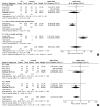Efficacy of Ethanol Ablation for Benign Thyroid Cysts and Predominantly Cystic Nodules: A Systematic Review and Meta-Analysis
- PMID: 33677930
- PMCID: PMC7937837
- DOI: 10.3803/EnM.2020.833
Efficacy of Ethanol Ablation for Benign Thyroid Cysts and Predominantly Cystic Nodules: A Systematic Review and Meta-Analysis
Abstract
Background: Ultrasound-guided minimally invasive procedures are widely used to treat thyroid diseases. The objective of this study was to assess the efficacy and safety of ethanol ablation (EA) in comparison with other non-surgical options in the treatment of benign thyroid cystic nodules.
Methods: We conducted a systematic search of studies on EA for thyroid cystic nodules, mainly in the Ovid-MEDLINE and Embase, Web of Science, and Cochrane databases. The standardized mean difference (SMD) of the volume reduction ratio (VRR) after EA versus other non-surgical treatments comprised the primary outcome, whereas the odds ratio (OR) of therapeutic success rates between the two groups comprised the secondary outcome.
Results: The meta-analysis included 19 studies (four randomized controlled trials and 15 non-randomized studies) with 1,514 participants. The cumulative VRR of EA was 83.908% (95% confidence interval [CI], 79.358% to 88.457%). EA had a significantly higher pooled VRR (SMD, 0.381; 95% CI, 0.028 to 0.734; P=0.030), but not a significantly higher pooled therapeutic success rate (OR, 0.867; 95% CI, 0.132 to 5.689; P=0.880), than other forms of non-surgical management including radiofrequency ablation (RFA), polidocanol sclerotherapy, and simple aspiration with or without saline flush. However, the VRR and therapeutic success rate were not significantly different between EA and RFA. Major complications were recorded only in six patients (0.53%) with self-limiting dysphonia.
Conclusion: The role of EA as the first-line treatment for benign thyroid cysts and predominantly cystic nodules is supported by its high effectiveness and good safety profile compared to other currently available non-surgical options.
Keywords: Ablation techniques; Cyst; Ethanol; Meta-analysis; Sclerotherapy; Thyroid nodule.
Conflict of interest statement
No potential conflict of interest relevant to this article was reported.
Figures





Similar articles
-
Solid benign thyroid nodules (>10 ml): a retrospective study on the efficacy and safety of sonographically guided ethanol ablation combined with radiofrequency ablation.Int J Hyperthermia. 2020;37(1):157-167. doi: 10.1080/02656736.2020.1717647. Int J Hyperthermia. 2020. PMID: 32024398
-
[Anhydrous Ethanol Improves Efficiency of Radiofrequency Ablation for the Treatment of Benign Thyroid Nodules:A Prospective Randomized Controlled Trial].Zhongguo Yi Xue Ke Xue Yuan Xue Bao. 2020 Jun 30;42(3):331-337. doi: 10.3881/j.issn.1000-503X.11512. Zhongguo Yi Xue Ke Xue Yuan Xue Bao. 2020. PMID: 32616128 Clinical Trial. Chinese.
-
Comparative Efficacy and Safety of Radiofrequency Ablation and Microwave Ablation in the Treatment of Benign Thyroid Nodules: A Systematic Review and Meta-Analysis.Korean J Radiol. 2024 Mar;25(3):301-313. doi: 10.3348/kjr.2023.1004. Korean J Radiol. 2024. PMID: 38413114 Free PMC article.
-
Ethanol ablation of benign thyroid cysts and predominantly cystic thyroid nodules: factors that predict outcome.Endocrine. 2014 May;46(1):107-13. doi: 10.1007/s12020-013-0035-7. Epub 2013 Aug 16. Endocrine. 2014. PMID: 23949907
-
Innovative Techniques for Image-Guided Ablation of Benign Thyroid Nodules: Combined Ethanol and Radiofrequency Ablation.Korean J Radiol. 2017 May-Jun;18(3):461-469. doi: 10.3348/kjr.2017.18.3.461. Epub 2017 Apr 3. Korean J Radiol. 2017. PMID: 28458598 Free PMC article. Review.
Cited by
-
Ultrasound-guided ethanol ablation versus the Sistrunk operation as a primary treatment for thyroglossal duct cysts.Ultrasonography. 2024 Jan;43(1):25-34. doi: 10.14366/usg.23128. Epub 2023 Sep 2. Ultrasonography. 2024. PMID: 38087396 Free PMC article.
-
Status of thyroid surgery-related medical disputes in China.Gland Surg. 2025 Feb 28;14(2):196-206. doi: 10.21037/gs-24-448. Epub 2025 Feb 25. Gland Surg. 2025. PMID: 40115861 Free PMC article.
-
Complications after thermal ablation for thyroid nodules across countries.Front Endocrinol (Lausanne). 2025 Jul 29;16:1608164. doi: 10.3389/fendo.2025.1608164. eCollection 2025. Front Endocrinol (Lausanne). 2025. PMID: 40801030 Free PMC article.
-
The Comparison of Efficacy and Safety between Radiofrequency Ablation Alone and Ethanol Ablation Followed by Radiofrequency Ablation in the Treatment of Mixed Cystic and Solid Thyroid Nodule.J Korean Soc Radiol. 2024 May;85(3):618-630. doi: 10.3348/jksr.2023.0056. Epub 2024 Jan 22. J Korean Soc Radiol. 2024. PMID: 38873386 Free PMC article.
-
Current role of interventional radiology in thyroid nodules.Front Endocrinol (Lausanne). 2024 Sep 17;15:1405705. doi: 10.3389/fendo.2024.1405705. eCollection 2024. Front Endocrinol (Lausanne). 2024. PMID: 39355619 Free PMC article. Review.
References
-
- Rojeski MT, Gharib H. Nodular thyroid disease. Evaluation and management. N Engl J Med. 1985;313:428–36. - PubMed
-
- Durante C, Grani G, Lamartina L, Filetti S, Mandel SJ, Cooper DS. The diagnosis and management of thyroid nodules: a review. JAMA. 2018;319:914–24. - PubMed
-
- Smith MD, Serpell JW, Morgan JL, Cheng MS. Fine needle aspiration in the management of benign thyroid cysts. ANZ J Surg. 2003;73:477–9. - PubMed
-
- Choi WJ, Baek JH, Choi YJ, Lee JH, Ha EJ, Lee WC, et al. Management of cystic or predominantly cystic thyroid nodules: role of simple aspiration of internal fluid. Endocr Res. 2015;40:215–9. - PubMed
Publication types
MeSH terms
Substances
LinkOut - more resources
Full Text Sources
Other Literature Sources

